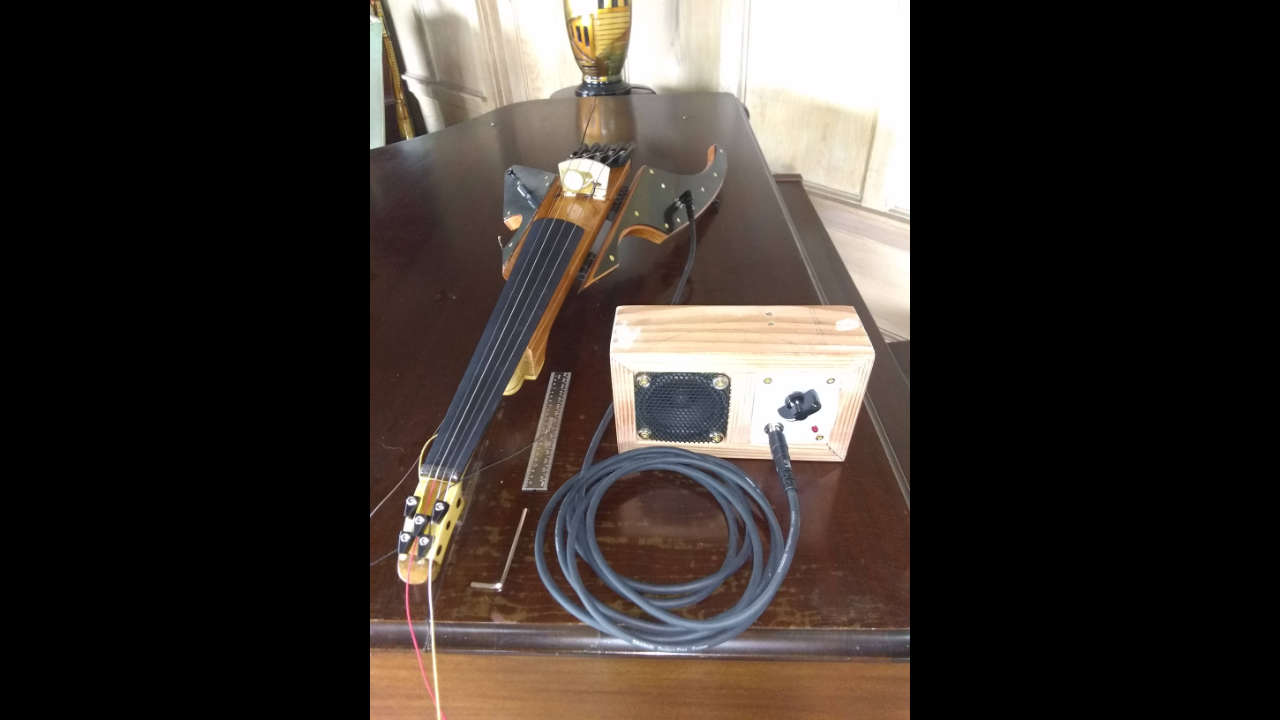Electroacoustic Polychord
A stringed instrument with feedback is formed from a plurality of very long music wires with custom-made, stereo pickup and driving transducers (that was the actual patentable improvement) located at opposite ends of the strings.
 The concept is that the string becomes a hybrid interface to an audio electronic controller. The string becomes extended into the electronics, but the musician has direct tactile contact with the controller. The first two incarnations were single-string "Monochords", but really a 4-string polychord would be more ideal and would require an 8-channel sound board and 8 channels of amplification to run it. Much more expensive than the original. The first incarnation was a student project. The second was a funded commission for New Music Chicago's 1985 Spring Festival. It was installed and performed at the State of Illinois at Chicago Building. At the end of the first installation, the instrument actually went into an unexpected uncontrolled, low-frequency self-oscillation that ripped the cones right off of the (borrowed - Yikes!) PA speakers I was using. So, I think that some further experiments in amplitude-limiting in the audio chin might also be called for this go-round. The first incarnation looked good, but was not acoustically ideal. The second incarnation was acoustically better, but not as sturdy as the first version. A third installation will look better, be more robust and have great acoustical properties. The first installation was in 1979. The second, as I said was 1985. It was a few months to construct a new version of the instrument each time. The first instrument was made of wood. The second was plastic and aluminum. I use tools.
The concept is that the string becomes a hybrid interface to an audio electronic controller. The string becomes extended into the electronics, but the musician has direct tactile contact with the controller. The first two incarnations were single-string "Monochords", but really a 4-string polychord would be more ideal and would require an 8-channel sound board and 8 channels of amplification to run it. Much more expensive than the original. The first incarnation was a student project. The second was a funded commission for New Music Chicago's 1985 Spring Festival. It was installed and performed at the State of Illinois at Chicago Building. At the end of the first installation, the instrument actually went into an unexpected uncontrolled, low-frequency self-oscillation that ripped the cones right off of the (borrowed - Yikes!) PA speakers I was using. So, I think that some further experiments in amplitude-limiting in the audio chin might also be called for this go-round. The first incarnation looked good, but was not acoustically ideal. The second incarnation was acoustically better, but not as sturdy as the first version. A third installation will look better, be more robust and have great acoustical properties. The first installation was in 1979. The second, as I said was 1985. It was a few months to construct a new version of the instrument each time. The first instrument was made of wood. The second was plastic and aluminum. I use tools.
Side story Guitar E-string is nearly invisible stretched through the air -- e.g., Music Wire. One of the student stage hands walked through the string the afternoon of the concert and knocked over the driving transducer half of the instrument breaking the bridge. I had to run home and repair it the afternoon of the debut concert. Six years later, the instrument was stretched vertically which kept the string out of potential traffic. That's important.
Frequently Asked Questions
What inspired you to do this?
Interactive tactilization of electrical feedback on a very long string.
How long did it take to make it?
Years, ... Decades -- it's not done yet
How long have you been doing things like this?
1979
How much did this cost to do?
The project gant budget for these things tends to be in the neighborhood of $1500, but that is never a complete number.
Have you done other things like this?
Yes
What did you wish you knew before you started this?
Guitar amplifiers/speakers are not built to operate out of the bandwidth range of a guitar. They can self-destruct.
Are there plans available to make this? Do you sell this?
It's patented (1980) and now in the public domain. The patent is supposed to be all the necessary knowledge to reproduce it. US patent 4,248,120. The Perspectives of New Music article (1981-1982) is in JSTOR.
What’s next?
Build a 4-string polychord with driving transducers impedance-matched to the string mass/linear distance and performance by a qualified experimental string player (my son, Nathaniel Dickson).
Resoures?
It all pre-dated the Internet (WWW). I've got tools. The first one was mainly wood. The second one plastic and aluminum.
Stewart Dickson
: Maker

Tourette's. I had cards printed "Art & Technology" in 1982. I got glazed looks from people I gave my cards to. My influences are the Billy Klüver/Robert Rauschenberg "Experiments in Art and Technology" (E.A.T) of 1962+. The best way to beat swords into plowshares is to subvert the tools of the Military-Industrial Complex into making Art.
Connect with Stewart Dickson
How I can help you:
I founded a Makerspace at the Urbana-Champaign Independent Media Center in 2009-2010, but I fell into a role more like a promoter/cheerleader than an educator/facilitator.
I founded a Makerspace at the Urbana-Champaign Independent Media Center in 2009-2010, but I fell into a role more like a promoter/cheerleader than an educator/facilitator.
How you can help me:
Cheer me on!
Cheer me on!